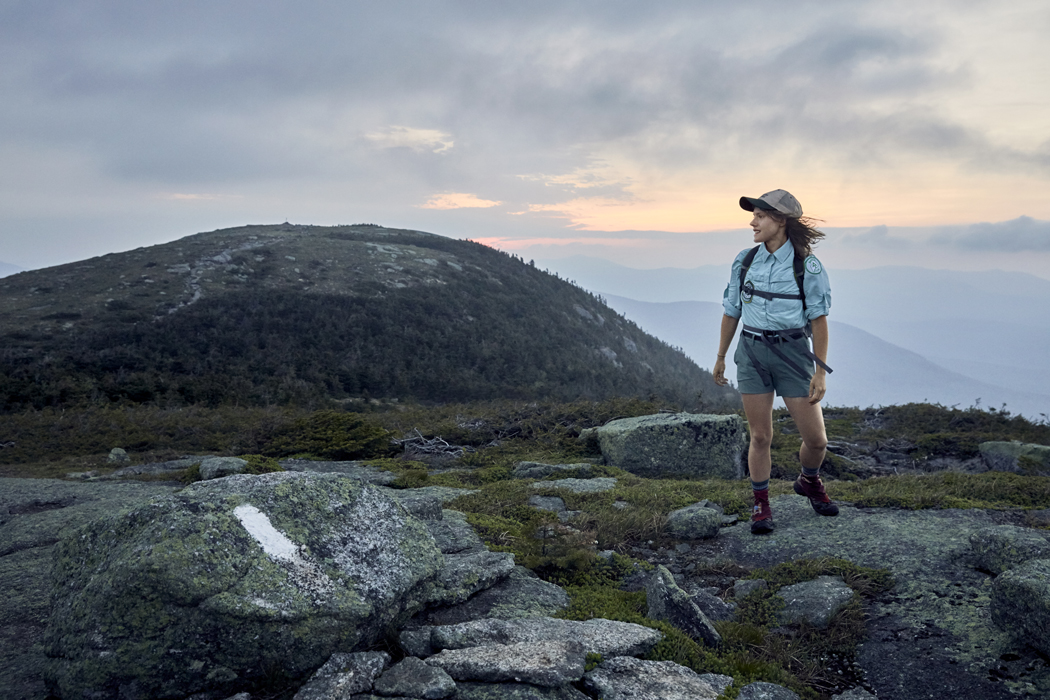By Kathryn Miles
Photographed by Michael D. Wilson
From our August 2017 issue
In August of 1937, a crew from the Civilian Conservation Corps completed the final link of the nascent Appalachian Trail — right here in Maine, between Sugarloaf and Spaulding mountains. The construction of the iconic footpath, stretching 2,190 miles from Georgia to Katahdin, owed to the efforts of dedicated trail clubs and volunteers. To celebrate the AT’s 80th anniversary, we checked in with five trail stewards, from all walks of life, who help make Maine’s 282 miles of trail a wilderness experience like no other.

The Trail Blazer
Lester Kenway
Age: 63
Hometown: Bangor
Role: President and chief hard hat, Maine Appalachian Trail Club
Since the Maine Appalachian Trail Club was founded in 1935, thousands of its volunteers have worked to build and protect Maine’s stretch of the AT. It’s tough, sweaty work. Glaciers scoured away much of Maine’s topsoil over 10,000 years ago, leaving obstinate rock and root. The trail follows steep grades over some 52 summits, light on the switchbacks you’ll find on sections of trail farther south. Entropy is perpetual. The MATC estimates its wish list of maintenance projects will take 23 years to complete. The mastermind behind getting them done — and done well — is MATC president Lester Kenway.
Known as a pioneer in trail-building circles, Kenway cut his teeth working on the AT with his college outing club in 1972; later, as Baxter State Park’s trail supervisor, he developed routes and trail stabilization techniques that help get tens of thousands of people up and down Katahdin safely and with minimal impact. Today, he supervises and trains (and often joins) the MATC trail crews, mostly-volunteer teams that put in nine-hour days throughout the summer, sometimes hiking two hours to a project site while humping pickaxes, rigging equipment, and other hefty gear. Old trail hands will tell you that Kenway is nothing short of a legend in the AT community — also, that he’s famously reticent to talk about himself. When we caught up with him recently, fresh off a project on Katahdin, he instead heaped praise on his volunteers.
“Keeping up the trail requires weeks of effort by a crew of people,” Kenway said. “Our trail volunteers come from anywhere in the world — I’ve seen people from the UK, from France and Belgium and South Africa, which makes it kind of an interesting experience for everyone.” About half of his volunteers are in their 20s, he says, while a quarter or so are retired — and, to hear Kenway tell it, applicants need not be muscle-bound backcountry hotshots. “When we recruit them, we give them extensive information about the physical challenges, about biting insects. Trail maintenance may sound pretty challenging, but I think most anybody can do this.”
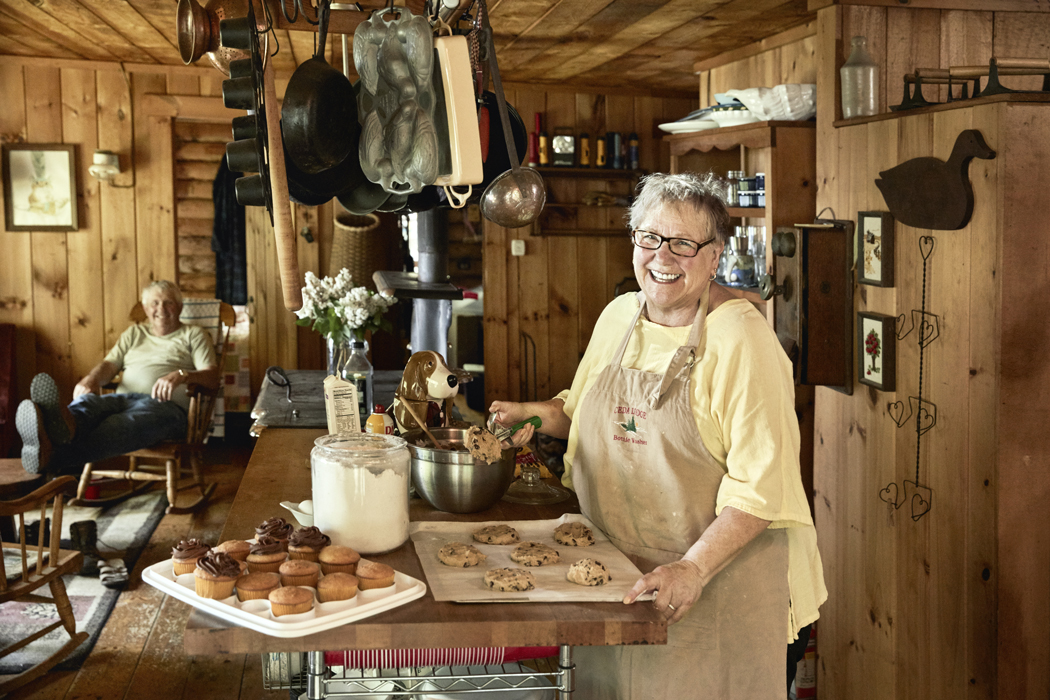
The Trail Angel
MaryEllen Royce
Age: 72
Hometown: North New Portland
Tools of her trade: Ghirardelli chocolate, heavy cream, unsalted butter
The Appalachian Trail Conservancy, a national outfit that preserves and manages the entire AT, defines trail magic as “an unexpected act of kindness” and a “quintessential part of the Appalachian Trail experience for many long-distance hikers.” For decades, veteran thru-hikers, religious groups, well-meaning locals, and others have made a hobby out of performing such small, generous gestures for thru-hikers. Sometimes, it’s as simple as a piece of fruit left anonymously on a hiker’s pack, maybe a lift into town to resupply. Other times, it’s coolers full of ice cream waiting at road crossings or elaborate barbeques hosted at trailheads.
MaryEllen Royce started performing trail magic 15 years ago, after she and her husband, David, both retired from teaching careers. They were spending a lot of time at their camp on West Carry Pond, just east of Mount Bigelow, and overheard hikers in the area describing how someone had made them blueberry muffins. Royce (who, not for nothing, has a master’s degree in Christian studies and pastoral ministry) decided she could do one better. These days, she bakes some 15 dozen goodies a week, everything from giant oatmeal cookies to her famous brownies with ganache frosting, which she and David deliver by pontoon to an AT overnight shelter on the far side of the pond.
“I’m a pastor without a ministry or a pulpit,” MaryEllen says, “but I love to do things for others. I’ve given all my life. I really think God put me on this earth to make people smile — and trail magic is a secular way to do that.”
MaryEllen makes regular trips to Sam’s Club in Bangor for penny candy and ramen noodles to pass out to hikers. When she has company for dinner, she makes extra and takes the leftovers up to the shelter as well — often with a box of wine and some dog biscuits. She estimates she spends an extra $2,000 a year on groceries just for trail magic. And she says it’s worth every penny.
“Every once in a while, David will ask if we really have to give the hikers all our wine,” she admits, “but mostly, he’s a good sport about it.”
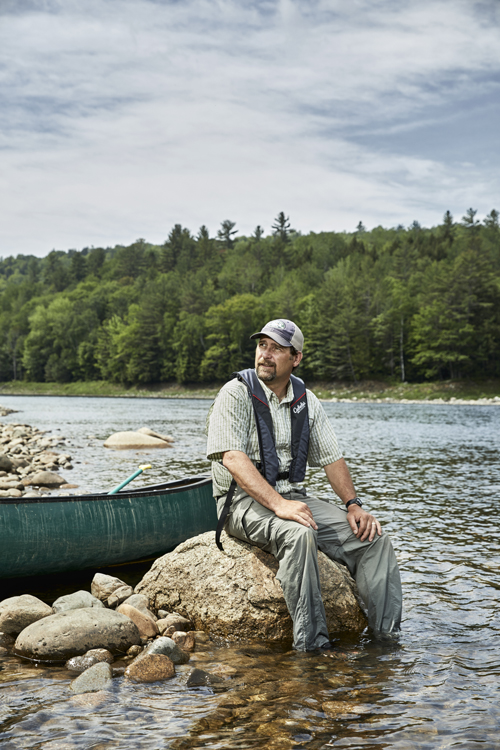
The Ferryman
Greg Caruso
Age: 47
Hometown: Millinocket
Other Gigs: Hunting, fly-fishing, and rafting guide
The Appalachian Trail crosses dozens of rivers, streams, and creeks, but only one requires a ferryman: the Kennebec River at mile 1,194, just outside of Caratunk. AT hikers have always relied on locals to get across. In the trail’s earliest days, residents simply left rowboats tied to trees; later, hikers sent postcards with their itineraries to local camp owners, who showed up ready to paddle. Some hikers have tried their luck with the 400-foot ford across the Kennebec, but it’s a dangerous proposition on the best day, especially so when dam releases upstream suddenly turn an otherwise placid river into surging whitewater. In 1985, a northbound thru-hiker drowned while attempting to cross with her husband. Soon after, the Appalachian Trail Conservancy instituted the official ferry crossing.
Greg Caruso is the third ferryman to hold the position. A veteran whitewater-rafting trip leader and Registered Maine Guide, he had little to do with the AT before taking the job last summer.
“I grew up with Katahdin in my backyard, but it never occurred to me to hike the AT,” Caruso says. “I guess I was just looking for something different — I mean, where else do raft guides go after they become old raft guides?
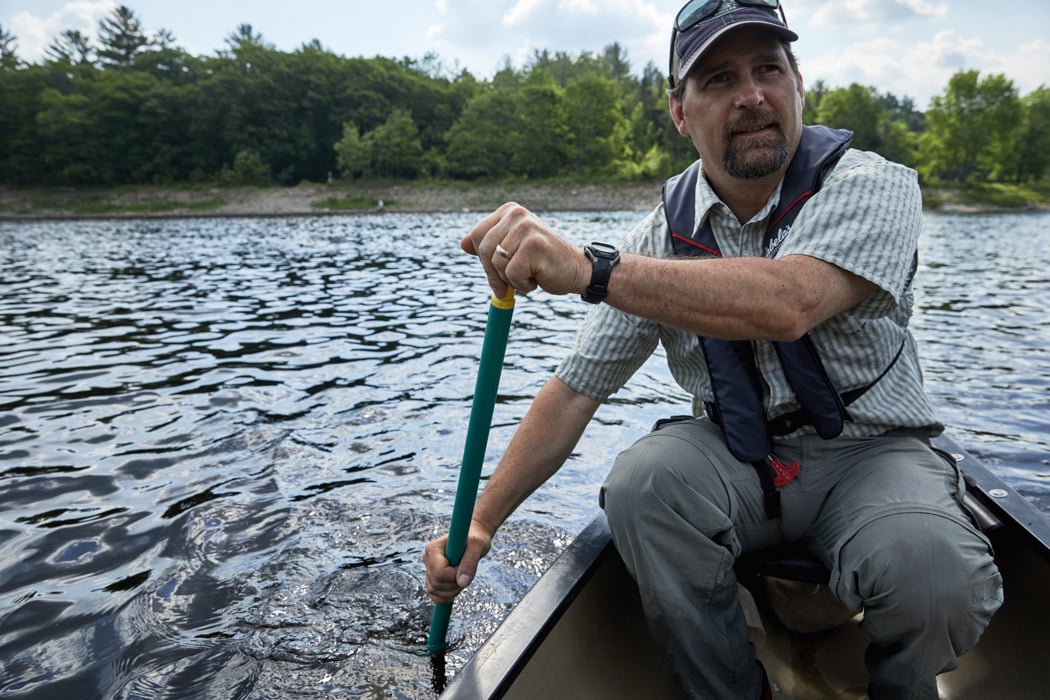
Each day on the job (a volunteer fills in on his days off), Caruso paddles his 17-foot Old Town Tripper back and forth across the Kennebec, transporting as many as 50 hikers on a busy day (he recently replaced his center thwart with a cane seat to accommodate two at a time). When the trail’s really bustling, his 11- and 13-year-old sons pitch in on getting (sometimes reticent) hikers to sign release forms. Last year, Caruso moved some 2,600 hikers from one bank to the other.
“I wasn’t sure how I was going to feel about taking a few thousand smelly hikers across a river,” Caruso teases, “but it’s bearable, especially if the wind is blowing the right way. Besides, it’s a really nice office. When it’s not busy, I’ll just park my canoe in the middle of the river and throw my fly rod for a little bit.”
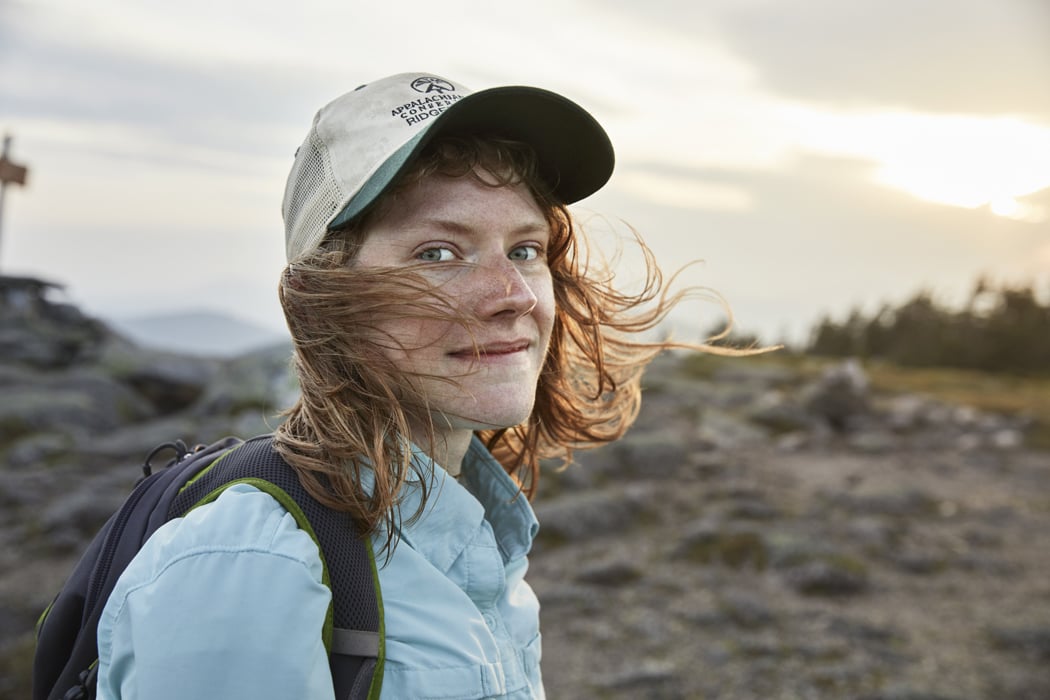
The Ridgerunner
Victoria Jofery
Age: 25
Hometown: Hermitage, Pennsylvania
Trail Name: Bluegrass
The Maine Appalachian Trail Club started employing caretakers in the 1970s, mostly interns from the Student Conservation Association, who spent their summers walking back and forth on a designated section of trail, checking its condition and ensuring hikers were safe. By the 1980s, such caretakers were found along the trail’s entire length. They came to be known as ridgerunners, and as the AT’s traffic has grown, so has their role.
Based at a campsite at the foot of Saddleback Mountain, first-year MATC ridgerunner Victoria Jofery spends a lot of her time educating hikers about “Leave No Trace” principles, the low-impact approach to outdoor rec that’s often summarized as “take only pictures, leave only footprints.” Outside the summer months, she works as therapeutic support staff for children with special needs, and she’s a thru-hiker herself — just last year, she hiked the AT southbound, beginning at Katahdin.
“It’s a lifestyle,” Jofery explains. “It’s kind of magical. And with all its summits and lakes and ponds, Maine was totally love at first sight for me.”

As a ridgerunner, she’s often on the trail for five days at a stretch — even longer when the volume of hikers is especially high. She’ll summit 4,116-foot Saddleback, Maine’s seventh-highest peak, countless times before her stint is up in October. (These, Jofery explains, are just some of the perks.) On trail, she’s on the lookout both for hikers in need and folks damaging natural resources, either through vandalism or simply a forgivable lack of knowledge.
“A lot of hikers view me as an authority figure or a police officer out to get people, but that’s not it at all,” Jofery says. “I’ll get up on summits and just talk to people, try to bridge that gap between nature and people. As a ridgerunner, I’m an environmental educator, trying to teach Leave No Trace as a philosophy — people don’t necessarily know that the grass is fragile, that there’s more to the ecosystem than just the little flowers.”
For Jofery, being a ridgerunner is a calling more than a job. “The AT is a life-changing place,” she says. “I came back from my thru-hike and felt like this job was the only right thing to do.”

The Hosts
Kim and Jarrod Hester
Ages: 37 and 38, respectively
Hometown: Ocala, Florida
Trail Names: Hippie Chick and Poet

The Appalachian Trail was never intended to be a wholly wilderness experience. Its original route spanned long stretches of road and even highway, and early thru-hikers regularly stopped in towns to resupply or enjoy a hot bath. The first hiker hostels popped up shortly after the trail’s completion; today, some 75 of them speckle the trail, with names like Broken Fiddle, Lickskillet, and Uncle Johnny’s Nolichucky. One is accessed via a zipline across a river; others offer made-to-order pizza, treehouse rooms, or boarding for four-footed hiking companions. But few are as storied as Shaw’s Hiker Hostel in Monson, founded by Keith and Pat Shaw in 1977.
Pat was a gifted cook, and Keith (“Old Man Shaw” to AT folks) sought to monetize his wife’s talents by luring hikers with the prospect of a home-cooked meal. Shaw’s quickly became known as one of the best breakfasts along the AT. Hikers ordered by number: a “three” got you three eggs, three pancakes, and three pieces of both bacon and sausage. The order numbers had no ceiling, and some hikers gleefully indulged in a “six” or a “seven.”
Today, the eggs are still cooked to order, and the pancakes (now made with Maine blueberries) are unlimited. Also unlimited: advice and expertise from Kim and Jarrod Hester, a pair of 2008 southbound thru-hikers who left their teaching jobs and moved to Monson to take over Shaw’s in 2015. With two young kids running around, the Hesters have instilled Shaw’s with an even more literal family vibe, and they have plans to expand into an outfitter and gear shop as well.
“We really liked the opportunity to own a family business and be a part of the trail,” Kim says, “so when we found out Shaw’s was for sale, we packed up and moved to Maine. It was always our favorite stretch: Maine is so rugged and beautiful.”
Many of Shaw’s guests, Kim says, could use a little extra hospitality after finishing the famously taxing Hundred Mile Wilderness, northeast of town. “They’re just broken,” she explains, “and our home is like a total breath of fresh air. We greet them with a cold beer or a Moxie, but we’re still known for our breakfasts. Every morning, Jarrod cooks up home fries and eggs in the same cast-iron skillets Old Man Shaw used to use.”
Take a Hike (and More) at the Appalachian Trail Conservancy Biennial
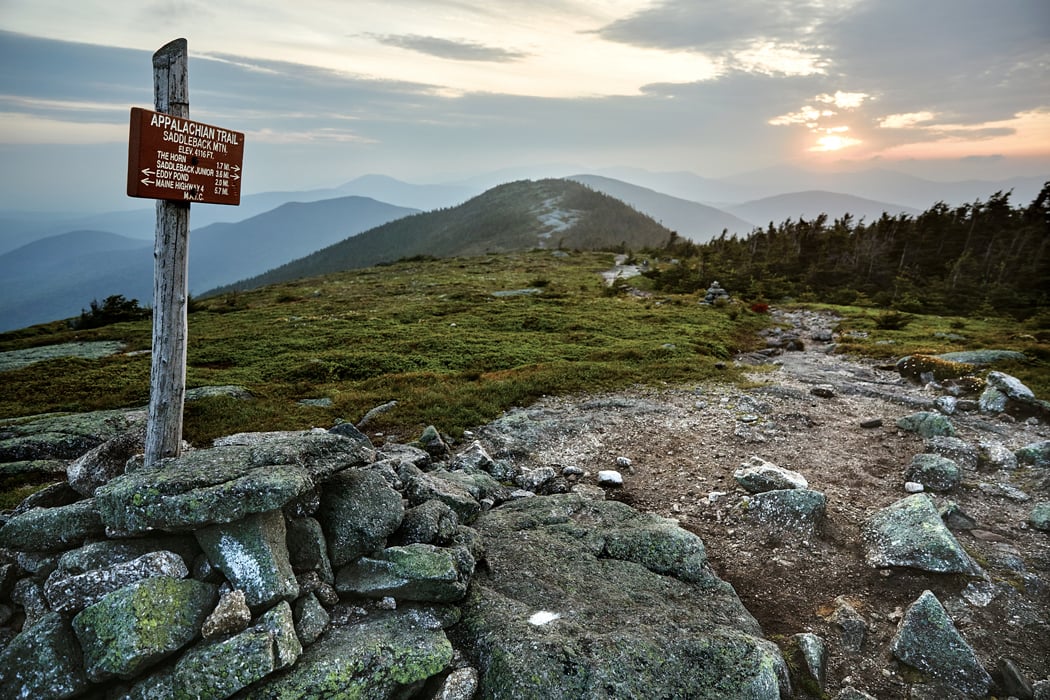
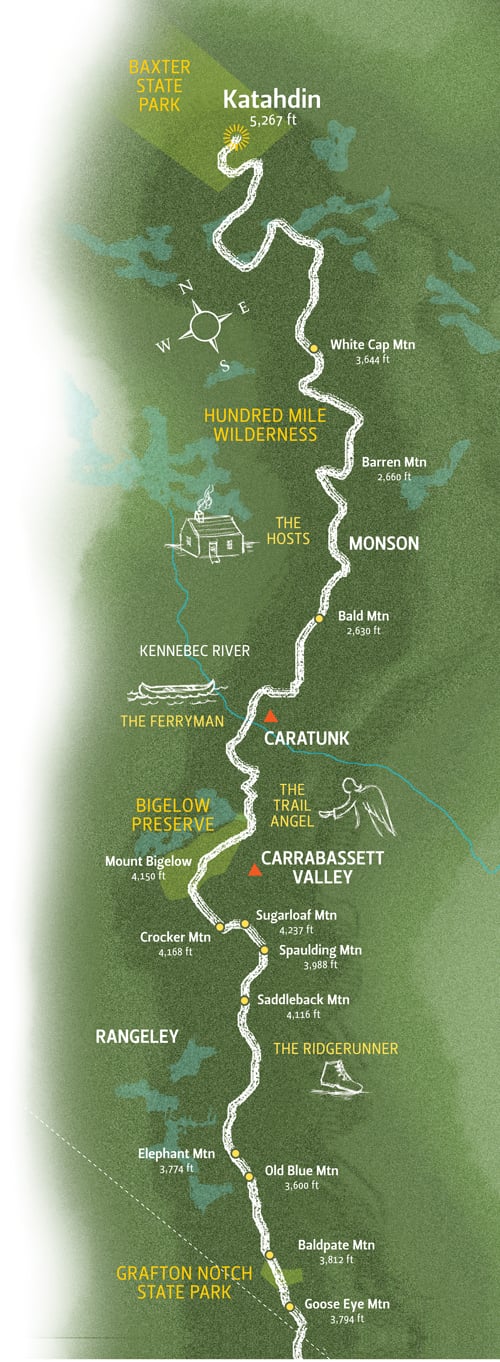
Every two years, in some town not far from the AT, the sprawling conference of the Appalachian Trail Conservancy gathers 1,000 or so staff, volunteers, and friends of the AT’s 31 trail-maintaining clubs for a weeklong to-do that’s part expo, part shareholder meeting, part freewheeling hiking jamboree. For the first time in 20 years, Maine hosts this year’s event, headquartered at Colby College in Waterville, August 4–11. “It’s a big deal,” says Claire Polfus, the ATC’s Maine program manager. “It’s pretty conference-y the first weekend, with workshops for people interested in trails — and the rest is just a big old party.”
Any hiking geek up for a big old party can register on-site, either for a single day ($45 adults, $20 ages 13–25) or the full week ($85 adults, $35 ages 13–25, plus another $40 to join the ATC, Maine Appalachian Trail Club, or Appalachian Mountain Club, if you’re not already a member upon arrival). Once registered, head over to the Hikes Desk to choose from a menu of some 240 guided hikes on offer throughout the week, exploring nearly every stretch of Maine’s AT, along with a dozen other classic Maine trails in the Camden Hills, on Tumbledown, and elsewhere. If you’re in good shape and up for an adventure (and spots are still available), tag along on the special 80th anniversary hike over Lone, Spaulding, and Sugarloaf mountains, which will visit the bronze plaque commemorating the trail’s completion. Slots are limited, and drive times and skill levels vary, but you can’t beat the company — or the trips to local restaurants and wineries that follow many excursions.
Off trail, wander an exhibit hall full of AT-friendly organizations and vendors hawking everything from backpacking gear to camping chow to apps and maps. Or drop in on live concerts, fly-casting tutorials, swing dances, and more. Aug. 4–11. Colby College, 4000 Mayflower Hill Dr., Waterville. atc2017.org
Kathryn Miles (kathrynmiles.net) lives in Portland and is the long trails correspondent for outsideonline.com. She’s the author of three books. Her latest, Quakeland, will be released by Dutton on August 29.
Michael D. Wilson (mdwphotographic.com) is a Down East contributing photographer and thru-hiked the AT northbound in 2013 (trail name: Dumptruck). His limited-edition book, Northbound, features more than 100 portraits of hikers and others he encountered during six months on the trail.



